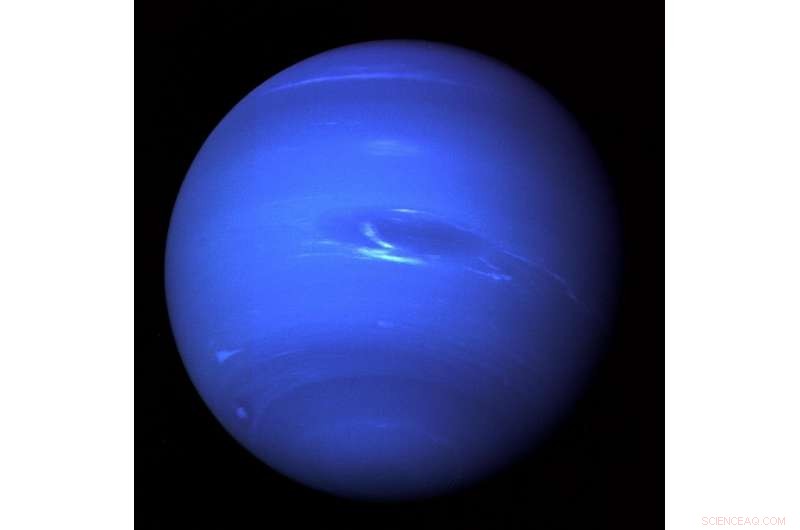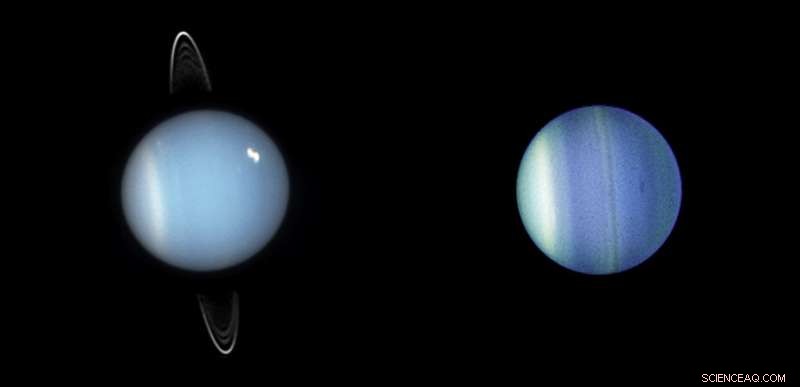
Esta imagen de Neptuno de la Voyager 2 muestra un mundo frío y oscuro azotado por el viento. En 1989, La Voyager 2 de la NASA se convirtió en la primera y única nave espacial en observar el planeta Neptuno, pasando alrededor de 3, 000 millas sobre el polo norte del planeta. Crédito:NASA / JPL-Caltech
Los lejanos Urano y Neptuno, los gigantes de hielo de nuestro sistema solar, son tan misteriosos como distantes. Poco después de su lanzamiento en 2021, El telescopio espacial James Webb de la NASA cambiará eso al descubrir los secretos de las atmósferas de ambos planetas.
Los planetas gigantes fríos y remotos Urano y Neptuno reciben el apodo de "gigantes de hielo" porque sus interiores son composicionalmente diferentes a los de Júpiter y Saturno. que son más ricos en hidrógeno y helio, y son conocidos como los "gigantes gaseosos". Los gigantes de hielo también son mucho más pequeños que sus primos gaseosos, siendo de tamaño intermedio entre los planetas terrestres y los gigantes gaseosos. Representan la categoría de planeta menos explorada de nuestro sistema solar. Los científicos que utilizan Webb planean estudiar los patrones de circulación, la química y el clima de Urano y Neptuno de una manera que solo Webb puede hacerlo.
"La clave que Webb puede hacer es muy difícil de lograr desde cualquier otra instalación es mapear su temperatura atmosférica y estructura química, "explicó el líder de los estudios, Leigh Fletcher, profesor asociado de ciencia planetaria en la Universidad de Leicester en el Reino Unido. "Creemos que el tiempo y el clima de los gigantes de hielo van a tener un carácter fundamentalmente diferente en comparación con los gigantes gaseosos. Eso es en parte porque están muy lejos del Sol, son más pequeños y giran más lentamente en sus ejes, pero también porque la mezcla de gases y la cantidad de mezcla atmosférica es muy diferente en comparación con Júpiter y Saturno ".
Todos los gases en las atmósferas superiores de Urano y Neptuno tienen huellas químicas únicas que Webb puede detectar. Crucialmente, Webb puede distinguir una sustancia química de otra. Si estos productos químicos son producidos por la luz solar que interactúa con la atmósfera, o si se redistribuyen de un lugar a otro mediante patrones de circulación a gran escala, Webb podrá ver eso.
Estos estudios se realizarán a través de un programa de Observaciones de Tiempo Garantizado (GTO) del sistema solar liderado por Heidi Hammel, un científico planetario y científico interdisciplinario de Webb. También es Vicepresidenta de Ciencias en la Asociación de Universidades para la Investigación en Astronomía (AURA) en Washington. El programa de D.C. Hammel demostrará las capacidades de Webb para observar objetos del sistema solar y ejercitará algunas de las técnicas específicas de Webb para objetos que son brillantes y / o se mueven en el cielo.
Urano:el planeta inclinado
A diferencia de los otros planetas de nuestro sistema solar, Urano, junto con sus anillos y lunas, está inclinado de lado, girando aproximadamente en un ángulo de 90 grados desde el plano de su órbita. Esto hace que el planeta parezca rodar como una bola alrededor del Sol. Esa extraña orientación, que puede ser el resultado de una colisión gigantesca con otro protoplaneta masivo al principio de la formación del sistema solar, da lugar a estaciones extremas en Urano.
Cuando la nave espacial Voyager 2 de la NASA sobrevoló Urano en 1986, un polo apuntaba directamente al sol. "No importa cuánto gire Urano, "Hammel explicó, "la mitad estuvo a plena luz del sol todo el tiempo, y la otra mitad estaba en total oscuridad. Es la cosa más loca que puedas imaginar ".
Decepcionantemente, Voyager 2 saw only a billiard-ball smooth planet covered in haze, with only a scant handful of clouds. But when Hubble viewed Uranus in the early 2000s, the planet had traveled a quarter of the way around in its orbit. Now the equator was pointed at the Sun, and the entire planet was illuminated over the course of a Uranian day.
"Theory told us nothing would change, " said Hammel, "But the reality was that Uranus started sprouting up all kinds of bright clouds, and a dark spot was discovered by Hubble. The clouds seemed to be changing dramatically in response to the immediate change in sunlight as the planet traveled around the Sun."

These Hubble Space Telescope images show the varied faces of Uranus. A la izquierda, Uranus in 2005 displays its ring system. The planet -- along with its rings and moons -- is tipped on its side, rotating at roughly a 90-degree angle from the plane of its orbit. In the Hubble close-up taken just one year later, Uranus reveals its banded structure and a mysterious dark storm. Crédito:NASA, ESA, and M. Showalter (SETI Institute); Right:NASA, ESA, L. Sromovsky and P. Fry (U. Wisconsin), H. Hammel (Space Science Institute), and K. Rages (SETI Institute)
As the planet continues its slow orbital trek, it will point its other pole at the Sun in 2028.
Webb will give insight into the powerful seasonal forces driving the formation of its clouds and weather, and how this is changing with time. It will help determine how energy flows and is transported through the Uranian atmosphere. Scientists want to watch Uranus throughout Webb's life, to build up a timeline of how the atmosphere responds to the extreme seasons. That will help them understand why this planet's atmosphere seems to go through periods of intense activity punctuated by moments of calm.
Neptune:A World of Supersonic Winds
Neptune is a dark, cold world, yet it is whipped by supersonic winds that can reach up 1, 500 miles per hour. More than 30 times as far from the Sun as Earth, Neptune is the only planet in our solar system not visible to the naked eye. Its existence was predicted by mathematics before its discovery in 1846. In 2011, Neptune completed its first 165-year orbit since its discovery.
Like Uranus, this ice giant's very deep atmosphere is made of a thick soup of water, amoníaco, hydrogen sulfide and methane over an unknown and inaccessible interior. The accessible upper layers of the atmosphere are made of hydrogen, helium and methane. As with Uranus, the methane gives Neptune its blue color, but some still-mysterious atmospheric chemistry makes Neptune's blue a bit more striking than that of Uranus.
"It's the same question here:How does energy flow and how is it transported through a planetary atmosphere?" explained Fletcher. "But in this case, unlike Uranus, the planet has a strong internal heat source. That heat source generates some of the most powerful winds and the most short-lived atmospheric vortices and cloud features of anywhere in the solar system. If we look at Neptune from night to night, its face is always shifting and changing as these clouds are stretched and pulled and manipulated by the underlying wind field."
Following the 1989 Voyager 2 flyby of Neptune, scientists discovered a bright, hot vortex—a storm—at the planet's south pole. Because the temperature there is higher than everywhere else in the atmosphere, this region is likely associated with some unique chemistry. Webb's sensitivity will allow scientists to understand the unusual chemical environment within that polar vortex.
Just the Beginning
Fletcher advises to be prepared for seeing phenomena on Uranus and Neptune that are totally unlike what we've witnessed in the past. "Webb really has the capability to see the ice giants in a whole new light. But to understand the continual atmospheric processes that are shaping these giant planets, you really need more than just a couple of samples, " he said. "So we compare Jupiter to Saturn to Uranus to Neptune, and by that, we build up a wider picture of how atmospheres work in general. This is the beginning of understanding how these worlds are changing with time."
Hammel added, "We now know of hundreds of exoplanets—planets around other stars—of the size of our local ice giants. Uranus and Neptune provide us ground truth for studies of these newly discovered worlds."
The James Webb Space Telescope will be the world's premier space science observatory when it launches in 2021. Webb will solve mysteries in our solar system, mira más allá a mundos distantes alrededor de otras estrellas, y sondear las misteriosas estructuras y orígenes de nuestro universo y nuestro lugar en él. Webb is an international program led by NASA with its partners, ESA (Agencia Espacial Europea) y Agencia Espacial Canadiense.